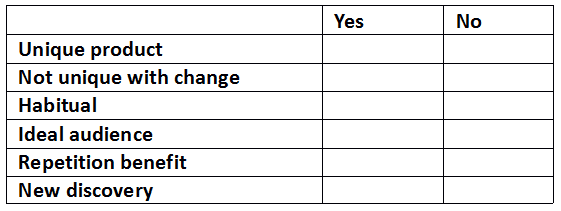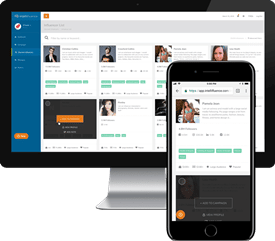Last Updated on June 8, 2020
Here’s the scenario: you’re back for more influencer marketing. Either the previous campaign went well, or it didn’t and you know why it didn’t. This strategy discussion will explore the best way to approach that second wave, regardless of what happened. If you’re new to this and haven’t had a first pass on using product reviewers for influencer marketing, do this:
- Figure out a buyer persona for what you’re selling. Sometimes this is hard and you need to go deeper.
- Determine the social network best suited for your product.
- Settle on the influencer type needed to give you the most success (hint: probably a peer influencer).
- Pick your product reviewers.
- Pitch those reviewers.
- Come back here when you’re done.
Can you guess how we at Intellifluence like to come up with the best strategy, when it comes to a potentially complicated decision? That’s right, we made a decision matrix!
Replay or New Game? Decision Matrix

Unique product — this question is looking to determine if you are going to be seeking reviews on the same exact product or an entirely different product. All things being equal, if the previous campaign was a success and the product is unique, there is a dual benefit to approaching a reviewer you worked with in the past. Not only do you know that the audience is receptive to the influence, but by repeating brand messaging, you are playing upon one of the core tenants of compulsion marketing by piling on. On the other hand, if the reviews sought are for the exact same product, the benefit of using the same reviewer is diminished and a new reviewer is likely a better fit.
Unique with change — based on the initial question, if the product is the same as used in the first wave of reviews, but changes have been made based on reviewer feedback, then it is overwhelmingly better to use the initial reviewers again. There’s a strong positive psychological effect in letting someone know that not only did you value their feedback, you incorporated it. These follow up reviews are almost always glowing, with influencers going out of their way to point out the product improvements and overlooking remaining flaws. Audiences that were exposed to the initial review and the follow up review are also deeply influenced, perceiving the brand as more caring about its consumer base.
Habitual — the nature of this question is to determine if the product in question is one of constant use and purchase. For instance most consumables such as cosmetics, food/drink, and other possible commodities wrapped into unique services like Uber or Airbnb are very habitual. The more habitual a product is in its use, the greater benefit there is in using the initial reviewers again. The less habitual, the better off you may be in selecting a new batch of reviewers for the second round.
Ideal audience — while you may have done your best to pick the product influencers with the information you had at hand, sometimes we discover more by undertaking a campaign. For the previous campaign, were you able to determine if the audience of the reviewer was ideal (i.e. matched your buyer persona), regardless of whether or not they performed the action you wanted? If it was, message repetition may be useful in further reaching the audience. If the audience was not ideal, then the decision to use new reviewers is easier.
Repetition benefit — is the buyer persona susceptible to advertising repetition per the compulsion marketing concepts discussed in a previous discussion on maximizing exposure? This is covered somewhat in asking about habitual product use and ideal audience fit, but further, it seeks to answer a question for the product type rather than the product itself. Within your industry, is there a significant use of retargeting ads to continually remind potential consumers of specific brands relevant to products that can be purchased anywhere? I find e-commerce stores that aren’t also the manufacturer of the products they sell fall into the category of benefiting from repetition benefit — in those cases, using the old reviewers has its benefit. This is less true of very unique products where there are not many sellers, or clear alternatives.
New discovery — from the last round to this round time has passed and there may be other influencers available for you to compare against the previous reviewer selections. Are any of these new influencers a better fit per the picking product reviewer article referenced above? If so, it may be a clear win to use new influencers.
Case Study: Frank Body
This mock case study would be for Sandra Kirwan of Frank Body. Note, Frank Body has done an incredible job using mid-level authoritative and strong influencers for their line, to the point where they have been covered internationally for their success.
I have no knowledge of their plans, so here’s a guess on how they would make a determination on using the same influencers or moving to fresh influencers.

Unique product? One of the products I see on Instagram is the original coffee scrub, the product that launched Frank Body. However, they have over 10 pretty unique products. Assuming the obvious success the first round of influence of the original coffee scrub had, if a different product is selected, using the same reviewers would score a point.
Unique with changes? This I am uncertain on. It is entirely possible that product changes or perhaps packaging changes were made over the years — we’ll skip this.
Habitual? Cosmetics is such a great industry because if the product works, repurchases are high. Per our earlier notes, habitual products do benefit from repeat reviews. Another unrelated note for Frank Body would be to create a subscription service at slight discount so a lazy person like me could get an order of coffee scrub on a monthly basis without needing to come back every month.
Ideal audience? Again, this is very clear that for most of the Instagram influencers selected, the buyer personas were 100% and the audience is ideal, given the commercial success. Another point for the repeat reviewers.
Repetition benefit? Cosmetics are constantly compared against each other for their efficacy; as such, it is the brand and product benefits that consumers need to be constantly reminded of as being a superior choice. Point for repeat reviewers.
New discovery? The likelihood of finding drastically better influencers is somewhat low, considering how well their initial campaigns have worked out. However, by mapping the audience of their existing influencers and comparing it against the possibility of using new influencers they may find areas where some individuals matching their buyer persona have not yet been reached. At present, I would still say the point goes to a repeat reviewer, but I would not rule out discovery sourcing a better fit.
A Twist!
What if you didn’t have to choose? The beauty of peer reviewing influencers is they tend to be far more affordable than other forms of marketing. As such, you don’t necessarily have to choose using new over old reviewers or vice versa. As a twist, you could approach a new batch of product reviewers like you approached the last batch, while also re-approaching the old influencers with a different offer, such as money to re-promote their old review with language on how they still use the product or mentioning product changes (i.e. now in mint!). You may be surprised at how effective and cost favorable such re-promotions are.
Have you read this article and want to get started with influencer marketing? Try it out.

Joe, CEO and Co-Founder of Intellifluence, has over 25 years of experience in SEO, leading several successful marketing companies and providing expert consultation. He is the author of The Ultimate Guide to Using Influencer Marketing, which is available as an eBook or in print.






